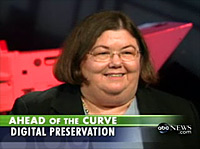November 13, 2007 -- Martha Anderson has been named director of program management for the National Digital Information Infrastructure and Preservation Program (NDIIPP).

Martha Anderson, new NDIIPP director of program management
Anderson, who joined the Library of Congress in 1996, has been acting in this position since April 2007. NDIIPP is the Library’s program to build a national network of partners dedicated to the collection and preservation of important digital materials that are at risk of loss if they are not now preserved. The program focuses on born-digital content; that is, materials that are created digitally and exist in no other form, such as electronic journals and Web sites.
"Martha has been critical to the success of NDIIPP since the program was authorized by Congress in 2000," said Laura E. Campbell, associate librarian for Strategic Initiatives, whose office is leading this program. "She was also a key player in the Library’s digital programs from their early days, including her outstanding work on American Memory, our flagship Web site."
"I look forward to many exciting opportunities ahead as I take on this new role," said Anderson. "The Library’s digital programs have helped transform the institution, bringing it new constituencies nationwide. The digital preservation program will ensure that our cultural heritage, much of which is today created digitally, is preserved and accessible for generations to come."
NDIIPP currently has more than 100 partners in its growing digital preservation network, which includes institutions both in the United States and abroad. The most recent partners to join the NDIIPP fold are from the private sector, as part of the Preserving Creative America initiative. These partners are collecting and preserving digital motion pictures, sound recordings, comics, photographs, video games and virtual worlds, such as those in Second Life.
